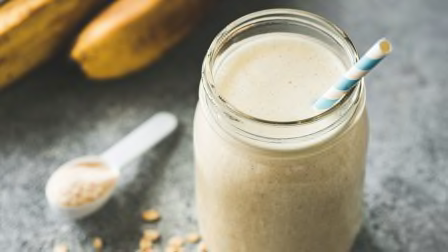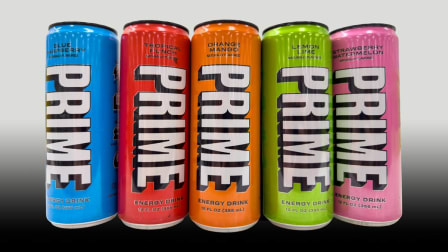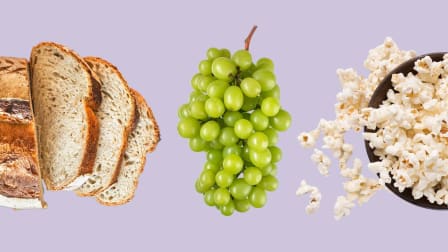Spotting Healthy Food Swaps
How to tell if you should trade half-and-half for plant-based creamers or try hearts of palm noodles, and more

Alternate versions of familiar foods—like bean rice, hearts of palm pasta, and plant-based chicken—are everywhere in supermarkets these days. Many of them seem to be better for you than the foods they’re meant to replace, but are you really making a healthy food swap when you choose them? We looked at five increasingly popular products and compared them with the original versions to help you decide which ones make for healthy foods swaps and which ones you should skip.
Plant-Based Creamers
Plant-based creamers are made from plant milks, like oat, coconut, soy, and almond, but they’re thicker, similar to half-and-half. Nutritionally, it probably doesn’t matter whether you opt for half-and-half or a plant-based creamer if you use it in small amounts, says Josephine Connolly-Schoonen, PhD, director of the nutrition division in the Department of Family Population and Preventive Medicine at Stony Brook Medicine in New York. A tablespoon of half-and-half has 20 calories and about 1 gram of saturated fat. Depending on the type of milk, creamers can have about 15 to 30 calories and 0 to 1 gram of saturated fat.
Grain-Free Cereals
Despite what you may have heard, trading your morning shredded wheat or oatmeal for a grain-free cereal isn’t necessarily a healthy food swap. “These cereals can make you think that there’s something wrong with eating grains, but that’s not the case,” Keating says. “Many studies show that including whole grains in your diet reduces the risk of heart disease, cancer, and more, and regular cereal can be a convenient way to get them.”
Still, some grain-free cereals can be good for you, such as grain-free granolas. These are typically made from a combination of nuts and seeds—which provide healthy fats, fiber, protein, and nutrients such as magnesium and potassium—in place of traditional oats. Just be mindful of added sugars and portion sizes. Ideally, a serving should have no more than 4 grams of added sugars. (Wildway Grain Free Apple Cinnamon Granola is one example of granola with zero added sugars.) “But the serving size on the package is often just between one-fourth and one-half cup,” Keating says. It can look puny in your bowl, so remember that if you double the serving, you double the calories, fat, and sugars.
Other grain-free cereals are often made with cassava, potato, and tapioca starches, or chickpea or lentil flour instead of grains. With the exception of the bean flours, which have protein and potassium, these ingredients don’t have much nutritional value. A recent CR test evaluated six grain-free cereals. None were flavor standouts, and only one, Forager Project Organic Grain-Free Os Cinnamon, received top scores for nutrition.
Hearts of Palm Pasta
The latest low-carb pasta alternative is hearts of palm, which is simply cut-up strips of the cream-colored vegetable. People say it’s close to the taste and texture of the real thing. It’s also very low in calories—about 50 per cup vs. about 200 per cup of cooked spaghetti.
“Considering most Americans don’t consume nearly enough vegetables daily, eating hearts of palm pasta is a great way to increase veggies in your diet,” Keating says. In a recent CR test, Palmini and Trader Joe’s hearts of palm pasta tasted pretty good, and with sauce, you could almost think you’re eating pasta. Palmini has more of an al dente texture.
Cauliflower and Chickpea Rice
Riced cauliflower is an excellent replacement for people looking to add in more fiber-rich vegetables with a negligible carb count, and it has about 20 calories per serving. Rice made from chickpeas isn’t much lower in carbs than the rice we know, but it does offer more protein and fiber. RightRice, made from lentil and chickpea flour, has 10 grams of protein and 5 grams of fiber in one-third cup (dry) compared with 5 grams and 2 grams, respectively, in brown rice. It also has about 180 calories per serving.
These products contain added salt for flavor. “Sodium is one of those things that entices people to eat too much,” Connolly-Schoonen says. Regular rice has little sodium unless you add it yourself. A serving of flavored RightRice, such as Thai Curry, has 390 mg. The original version is lower, at 145 mg, while Banza Chickpea Rice has just 70 mg. A serving of Green Giant frozen riced cauliflower rice has 20 mg. As long as you keep tabs on sodium (the recommended daily limit is less than 2,300 mg), these products can be a good pick, Connolly-Schoonen says. But don’t expect either to have the flavor or texture of regular rice. Some bean rices may not have a firm texture, and cauliflower rice has more crunch than chew.
Plant-Based Chicken
Some consumers think plant-based “meats” are healthier than the types they’re supposed to resemble, but that’s not always the case. The protein often comes in the form of soy or pea isolates. These proteins have been extracted from the original plant, but they aren’t the same as vegetables you buy at a produce stand. Another concern, Keating says, is that it’s not clear if replacing meats with these alternatives has the same health benefits as eating whole plant foods like beans, vegetables, and tofu. They can also be higher in sodium than the products they’re replacing. For instance, Gardein Plant-Based Chick’n Strips have 370 mg of sodium in about 3 ounces. The same amount of chicken breast has 63 mg. But if mock meats make it easier for you to start eating a more plant-based diet, having them a few times a week is fine.
Editor’s Note: A version of this article also appeared in the January 2023 issue of Consumer Reports On Health.



















